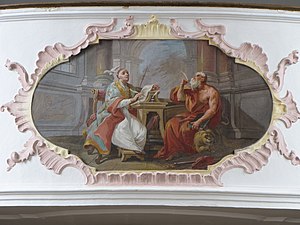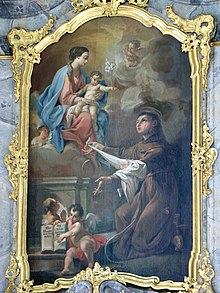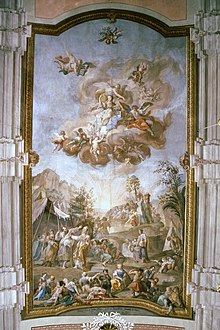Franz Anton Zeiller
Franz Anton Zeiller (born May 3, 1716 in Reutte ; † March 4, 1794 ibid) was an Austrian rococo painter .
Home and apprenticeship in Reutte
The founder of the Reuttener Zeiller line was Christoph Zeiller († 1628), Saltzfactor zue Reite, Zoller zue Binswang and Stadlmaister zue Leermos . The painters Franz Anton Zeiller and Johann Jakob Zeiller are descendants of his fourth generation from two different lines. Franz Anton, whose ancestors all worked in the salt trade, lost his parents very early. The painter Paul Zeiller (1658–1738), already the father of ten children (including Johann Jakob), took little Franz Anton into his family like his own child. He recognized the boy's talent in good time and trained him to be a painter, while his son Johann Jakob was already in Italy. From 1728 the highly talented painter Balthasar Riepp (1703–1764) from Kempten also worked in Paul Zeiller's Reutten workshop and continued to do so after his death. He had married the Zeiller daughter Anna Maria in 1735 and had long before taken part in the training of the young Franz Anton. While Paul Zeiller worked exclusively as a panel painter, Riepp was also familiar with the fresco style of Roman-Neapolitan painting.
Apprenticeship and traveling years in Augsburg (1738–1742)
After the death of Paul Zeiller, Franz Anton left his hometown Reutte. His journeyman migration initially took him to Augsburg . The ingenious Tyrolean painter Johann Evangelist Holzer (1709–1740) became the first style-forming teacher there . In 1738/39 Franz Anton Zeiller worked as Holzer's assistant in the former collegiate church of Münsterschwarzach . After Holzer's early death, Franz Anton continued his training with Gottfried Bernhard Göz (1708–1774), who was also considered an important engraver. He spent several years with him and was able to save a few 100 guilders . With the money he could have acquired the valuable legacy of Holzer, but the desire to see Italy and to complete his studies there won out .
Italian studies (1742–1749)
For his Italian studies, Franz Anton Zeiller chose stays in Rome (1742–1744) and Venice (1744–1749), combined with a short visit to Bologna (1744). In Rome he trained with Corrado Giaquinto and also copied paintings by the teacher in his workshop. Personal records of the studies in Rome and Bologna were preserved in Franz Anton Zeiller's “sketchbook”.
During the five years in Venice, Zeiller also studied and copied works by Tizian (actually Tiziano Vecellio, around 1490–1576), by Sebastiano Ricci (1659–1734) and other great masters, whose splendid coloring and richness of figures particularly interested him. Immediately after his return home, Zeiller reappeared from 1749 to 1751 as a “journeyman” with Gottfried Bernhard Göz, namely during the ceiling frescoes in the Birnau pilgrimage church . He was also involved in the production of a large-format and extensive painting cycle for the Abbot of Kaisheim .
First independent work in the Allgäu
Franz Anton Zeiller received his first commission in 1751/52 in the former Benedictine monastery of St. Mang in Füssen. The art-loving abbot Gallus Zeiller (r. 1750–1755), a distant relative, commissioned him to paint the ceiling in the Magnus Chapel (oil painting, surrounded by four fresco medallions). In 1753 the colorful frescoes and the high altar picture followed in the parish church of St. Martin von Sachsenried , which was subordinate to the Füssen monastery.
The extensive ceiling and cupola frescoes in the collegiate church of Ottobeuren , which Johann Jakob Zeiller and Franz Anton Zeiller shared, can be considered the highlight of a joint artistic creation. Franz Anton carried out the smaller portion, namely in the years 1757 to 1760. This was followed by further orders for frescoes in the Irsee Monastery (1761 painting of the refectory, not preserved), Rieden (1762) and Schlingen (1763). He painted altar leaves for Sachsenried (1753), Haslach (1758), Bachtel (1758), Mittelberg (1759), Maria Rain (1761), Schlingen (1763) and St. Stephan in Füssen (1764).
Orders in North Tyrol
The frescoing of the parish church of Stams , which was made in 1755, is the first work by Franz Anton Zeiller in North Tyrol . Zeiller also created two altarpieces there. In general , Zeiller's altarpieces from this first North Tyrolean period are among the highest quality oil paintings by the painter (in Tienzens , Kundl , Mils , Toblach ). No other frescoes from this period have been preserved.
Creative period in South Tyrol as court painter
Franz Anton Zeiller's appointment to Brixen by Prince-Bishop Leopold Graf Spaur took place around 1765 in connection with the new building of the Brixen seminary . In 1766 Zeiller made the frescoes in the seminary church. In the same year, the choir room in the parish church of Milland and the church of the English Misses in Bressanone (burnt down in 1839) followed. Up to 1774 further orders were added , especially in the Pustertal ( Strassen 1768, Toblach 1769, Taisten 1770/71, Brixen: Library in the seminary 1772, Cortina d'Ampezzo 1773, Uttenheim 1774). With his appointment as court painter in Brixen (decree of October 27, 1768), Franz Anton Zeiller had in the meantime received a high distinction and appreciation for his artistic activity because - as the decree says - he painted several different buildings of God in our diocese and even carried out such things in our residential town of Brixen, and indeed excellent ones in the same seminaris and at the English Institute House with all pleasure and happily .
Late creative period in North Tyrol
As the “Brixen court painter”, Franz Anton Zeiller came to Innsbruck in 1775 , where he had already acquired a residence. In 1775, at the age of almost 60, he took on the major order for the frescoes in Zell am Ziller . There he also made five altarpieces. In 1777 Zeiller painted further ceiling frescos in Innsbruck, 1778 in Ranggen , 1779 in Weer , and finally in 1783 in Matrei in East Tyrol . After Johann Jakob Zeiller's death (July 8, 1783), Franz Anton also returned to his native Reutte. But he didn't put the paintbrush aside here either. First, in 1785, he completed the fresco work in the choir of the parish church of Bichlbach , which Johann Jakob had already started painting the nave in 1778. He also complied with the request of the Wängle parish to paint their church, which had been consecrated in 1732, when he was 70 years old in 1786. Finally, in 1791, he also created the choir fresco in the former Expositurkirche in Grän . Several panel paintings have also survived from this period. On March 4, 1794 Franz Anton Zeiller - Celebris Pictor - died of dropsy of the heart. He was unmarried and had saved a considerable fortune by his modest way of life.
Personality and appreciation
We owe information about the person Franz Anton Zeiller and a contemporary assessment of his works to Franz Thomas Leu (1756–1800):
- He is of a single class and over 70 years of age, virtuous and righteous, without the slightest debauchery, lively, cheerful, agreeable and ready to serve, especially to the art-loving youth eager to learn.
- Through his art, however, he acquired a fortune that he may rightly be called rich, although he lived frugally.
- Suffice it to say that Franz Anton Zeiller can appear at any time among the greatest painters without blushing.
literature
- Constantin von Wurzbach : Zeiler, Franz Anton . In: Biographisches Lexikon des Kaiserthums Oesterreich . 58th part. Imperial-Royal Court and State Printing Office, Vienna 1889, p. 280 f. ( Digitized version ).
- Hans Semper: Zeiller, Franz Anton . In: Allgemeine Deutsche Biographie (ADB). Volume 45, Duncker & Humblot, Leipzig 1900, pp. 649-652.
- Irmgard Plankensteiner: The Brixen court painter Franz Anton Zeiller (1716-1794) . In: Exhibition catalog of the Reutte market town on the 200th year of death in 1994.
- Josef Mair: Genius in the Shadow, The painter Balthasar Riepp (1703-1764) , Reutte 2003, ISBN 3-901821-02-3 .
- Klaus Wankmiller: Franz Anton Zeiller (1716–1794). On the 300th anniversary of the death of the Ausserfern artist and Brixen court painter - Part I , in: Tiroler Heimatblätter 91 (2016), No. 1, pp. 8-13.
- Klaus Wankmiller: Franz Anton Zeiller (1716–1794). On the 300th anniversary of the death of the Ausserfern artist and Brixen court painter - Part II , in: Tiroler Heimatblätter 91 (2016), No. 2, pp. 77–82.
- Klaus Wankmiller: With a brush and palette! For the 300th birthday of Franz Anton Zeiller (1716–1794) . Catalog for the exhibition street (= publications of the Museum Association of the Reutte District - Volume X), Reutte 2016, ISBN 978-3-9503706-5-2 .
- Klaus Wankmiller: New and rediscoveries of pictures by Franz Anton Zeiller (1716–1794) . A supplement to the 300th birthday of the Reutte painter, in: Extra Verren - Yearbook of the Museum Association of the Reutte District 11 (2016), pp. 7–56. ISSN 1992-0261 .
- Klaus Wankmiller: Franz Anton Zeiller (1716 - 1794) and his work in the Allgäu and in southern Germany. On the 300th birthday of the Prince-Bishop of Brixen , in: Alt Füssen - Yearbook of the Historical Association of Alt Füssen (2016), 9–110.
Web links
Individual evidence
- ↑ Franz Anton Zeiller's sketchbook, Tyrolean State Museum Ferdinandeum in Innsbruck, inv. T 2870 (W3766).
- ↑ Josef Mair, p. 8, note 69.
- ↑ Decree of appointment as court painter in Brixen from October 27, 1768, Reutte local history museum.
- ^ Franz Thomas Leu from Braz / Vorarlberg. In: New Museum for Artists and Art Lovers, ed. by Johann Georg Meusel, 3rd piece, Leipzig 1794, p. 324 and 325.
| personal data | |
|---|---|
| SURNAME | Zeiller, Franz Anton |
| BRIEF DESCRIPTION | Austrian painter |
| DATE OF BIRTH | May 3, 1716 |
| PLACE OF BIRTH | Reutte , Tyrol |
| DATE OF DEATH | March 4, 1794 |
| Place of death | Reutte , Tyrol |







